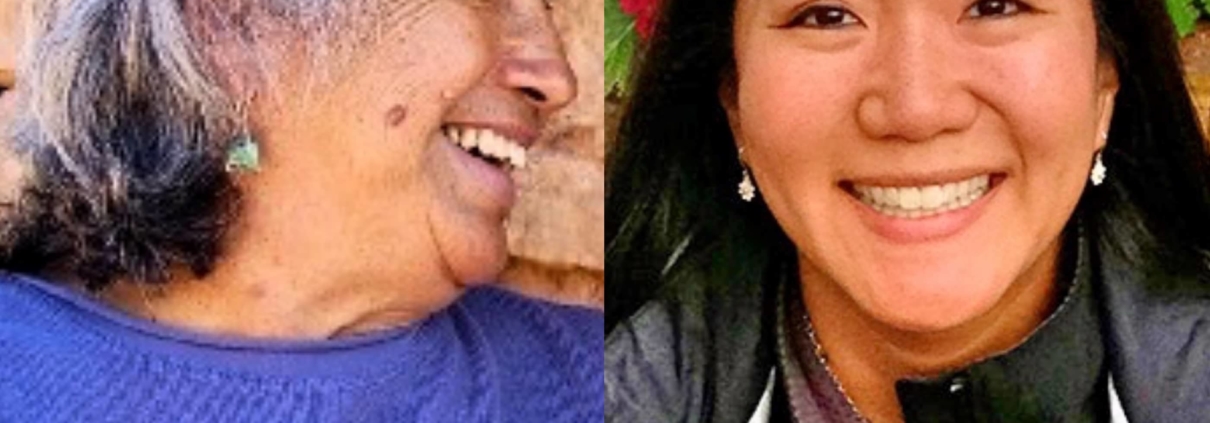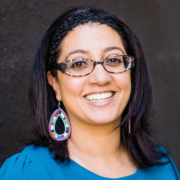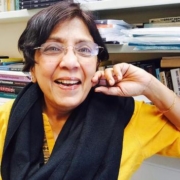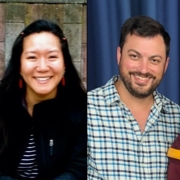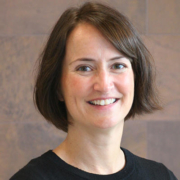Today I speak with Elizabeth Sumida Huaman and Tessie Naranjo about indigenous women and research. They have co-edited the latest issue of the International Journal of Human Rights Education, which was released last week.
Elizabeth Sumida Huaman is an associate professor of Comparative and International Development Education at the University of Minnesota. An Indigenous education researcher, her work focuses on the link between Indigenous lands and natural resources, languages, and cultural and educational practices in the North and South America. Tessie Naranjo lives in northern New Mexico and is an internationally recognized Indigenous community education, language revitalization, and arts advocate. She is a founder of the Pueblo Indian Studies Program at Northern New Mexico College where she served as faculty, and former co-Director of the Northern Pueblos Institute.
Citation: Huaman, Elizabeth Sumida & Naranjo, Tessie, interview with Will Brehm, FreshEd, 179, podcast audio, November 4, 2019. https://freshedpodcast.com/indigenouswomen/
Will Brehm 2:55
Elizabeth Sumida Huaman and Tessie Naranjo, welcome to FreshEd.
Elizabeth Sumida Huaman 3:00
Thank you for having us, Will.
Tessie Naranjo 3:01
I am glad to be here.
Will Brehm 3:03
So, let’s start by talking about colonization – a big topic. In your new co-edited volume, in your introduction, you call it a “strategy of imperialism that has left an indelible mark on colonized lands and people.” What sort of narratives has colonization constructed about indigenous peoples and lands?
Elizabeth Sumida Huaman 3:25
I can address that. We talked about this a little bit in our introduction, but I think maybe one of the things that we can clarify is that we’d like to differentiate colonization as a set of actions or patterns that empires will use towards expansion of their empire, and oftentimes that’s bounded by time. So, there is a period of colonization, and then what we’ve seen around the world in different national contexts, is that there’s then a time of decolonization or post-colonization, often referred to as “independence.” I think what Tessie and I are referring to, and what our authors are speaking to, is a condition called “coloniality.” And so, there is an Argentinian scholar that Tessie and I use; his name is Walter Mignolo, and he talks about “coloniality,” which is the ongoing condition of colonial oppression and struggle that’s exemplified through four domains. So, these are four areas where indigenous peoples are encountering resistance and struggle. So, we think very closely about those four domains as: control of economy, which includes manipulation of land and natural resources; control of authority, which is the creation of institutions – political and legal institutions, as well as military; this creation of what is considered normative, so that oftentimes is heavily influenced by ideas of religion, as well as gender and sexuality; and then, this control over knowledge, which is oftentimes most clearly exemplified by the construction of education, and what constitutes knowledge. So, in our issue, we really think very closely about how indigenous peoples are speaking to, or speaking back to, conditions of coloniality in all of those areas. And all of our authors, I think, write about those areas in one way or another. So, they address, really, that entire system of domains, and they address coloniality as a whole, but taking up different lenses. So, one of the things that I think is really important for us to think about is not just how coloniality has left, or leaves us, in a condition where there is that, you know, as we might refer to, this mark on lands and peoples. “Lands” meaning the impact to our natural resources: you know, our earth, our water, our animals, our skies, and so forth. But then also peoples, meaning bodies and psyches. And I think what’s really critical is that our authors who put forth their work so lovingly, speak to that condition. They speak to coloniality in some way or another. And so, for example, we have one author, June Lorenzo, who is from Laguna Pueblo, who talks about this idea, counters this idea, that land and natural resources are only for human exploitation or for capital gain. And she writes about uranium mining in her own village of Paguate in Laguna Pueblo. And we also have authors like Robin Minthorn and Heather Shotton, who take up this idea. So, they would be countering this normative view of gender and sexuality. And primarily, this idea of women in leadership; they take up this idea that you know, women are not leaders because they are not visible, for example, or as visible as men. And they really challenge that.
Tessie Naranjo 7:25
Well, I was thinking about answering the question in terms of fences. I am from one of the pueblos in northern New Mexico, and I have enough knowledge about the history of our place. And I was thinking about when the colonizers came in, first the Spaniards, and then later on the white Americans. And the idea of fences became a part of our understanding. Reluctantly. And so, I was thinking of fences in terms of creating borders and boundaries, and I was thinking of how these fences psychologically make us feel less than.
Will Brehm 8:15
It is interesting. I mean putting up these fences and borders and boundaries and feeling “less than” when thinking about coloniality. And Tessie and Elizabeth, you both sort of mentioned issues of knowledge and even education. And so, you know, I want to ask a little bit about how coloniality has impacted the very meaning of research. So perhaps, Elizabeth, maybe you can start.
Elizabeth Sumida Huaman 8:44
Sure. So, in terms of how coloniality has impacted research, you know, Tessie and I are, we are community members, and we are educators, and we write as well. And we think. And we speak. I think that you know, but we also come from places. We come from very strong peoples and places that we have very strong connections to. And I think one of the ways that coloniality has shaped dominant understanding of research is to devalue those places, and to devalue our interactions as intellectual beings, as spiritual beings, with those places. So, there are wonderful scholars, some of them in our special issue. Others like Linda Smith, who is a very highly regarded Māori scholar, who has really informed our thinking around decolonizing research approaches, who do that work very well. And they help us to understand how research can be transformed by indigenous peoples. I think one of the issues that we encounter consistently as indigenous peoples is that our knowledge isn’t really knowledge – that what we know, and how we’ve managed to live in a particular place over time, isn’t necessarily something that is considered valuable. You know, it’s this idea that: well, maybe indigenous peoples didn’t really know that much about their environment, or they lived in a way that was haphazard, or they were lucky. When in reality, indigenous peoples have very strong systems and ways of interacting and of living and of thriving in places. And I think that that’s one of the key issues that we are interested in as community members is this idea that we, too, have had research for a very long time as indigenous peoples. We maybe didn’t call it “research.” There’s lots of different ways in our languages that we think about inquiry, and we think about knowledge production. But I also think that there are different reasons that we sought to understand, or to know something, and there were different uses for what we did learn.
Will Brehm 11:15
I mean, it is interesting, the idea that you know, this coloniality, the domain of the normative, as you were saying earlier, and how that has sort of narrowed the very meaning of what science is, to, you know, the scientific method or Western science. But, in fact, there’s so many other and diverse ways of knowledge, of inquiry, of what we might call research, very broadly. And, you know, your special issue really sort of draws out all of these different, diverse traditions of what research could be, and has actually been marginalized by this sort of normative stance of what modern research is supposed to look like.
Tessie Naranjo 11:57
Well, I was thinking about the community that I come from and the pueblo world, that I know more about than any other tribal group. And I was thinking about how we have our own way of researching, so that we understand our place and our land, and I was thinking that our methods are different from that non-tribal world. And I was thinking of how we are more circular in our thinking, we are more fluid in our thinking, and in contrast to the Western way of researching, which is, I don’t know if you call it regimented, but it’s different than the way that we understand how to do things. And I will give you maybe an example or so of how we have learned to live off the land. For example, the irrigation. We are a traditional agricultural people, and so how we learn how to grow corn and beans and squash is something that we learn through experimentation. And so, “researching,” if you want to call it that, has been very much a part of our lives. And in terms of, for example, the pottery making that is a traditional part of our lives: how we’ve learned how to mix clays, and how we’ve learned how to use the plants for coloring the designs on our pots, all of that is a researching. Our place, our land, so that we know what its resources are. Our methods are different, but it is researching, nevertheless.
Elizabeth Sumida Huaman 13:50
Will, you know, to speak to your point about the Western scientific method, I think Tessie really exemplifies that with her description of pueblo knowledge and living as agricultural people. I think that one of the things that is really disturbing that we’re seeing about the condition of the earth. And what we are seeing in terms of environmental catastrophe today is the distancing of our relationship from our respect and our regard for place. Our respect and our regard for natural resources and land as living beings. And I think that one of the things that, you know, Western science is not our enemy. Western science in many ways, scientists today, I think, are starting to wake up to, and have been, you know, at least for the last several decades. There are voices and people who are talking about. And they are naming it different things. So, they are calling it things like biocultural diversity, you know, or concentric ecology, for example. So, there are people who are understanding and delving more deeply into this idea of relationships. And I think that indigenous peoples, because of our relationships and our regard and our exercise of values, we don’t just talk about the values of respect or the values of love for the things around us. We have ceremonies, we have activities, we have daily things that we do as community members and as individuals, that put those into practice. And I think that people are seeing the importance and the value of that, and certainly, our authors are seeing that. So, for example, we have Danelle Cooper and her coauthors, her wonderful professor-mentors, who have really shaped a beautiful submission that highlights a couple of different sacred places, one of them being Mauna Kea in Hawaii. And we see there the tension between Western science and this drive to build, you know, super telescopes and more telescopes, and things that can really help humans to explore the universe in ways that assume that indigenous peoples didn’t have the capacity, or the technology, to do that. And I think we are talking about different purposes and different uses of technology, different definitions of technology. And I think so much of it comes back to purpose: Why do we seek knowledge? Why do we think about science the way we do? What is the ultimate goal for us? And for many of us who are really attempting to reclaim those connections to the beautiful things around us, and to appreciate the gift of life that we’ve been given, the purpose is to sustain life and to live a life of values and quality where, you know, children and communities and all the creatures can flourish. So, I don’t know that it’s necessarily a clash of Western science because Western science can be used as a tool of and as a resource for us. But it is: what is the purpose, you know? And I think that you know, those of us who were colonized by the Spanish – and there were many communities that were colonized by the Spanish back in the 1500s – you know, we joke about the Spanish being some of the very early colonial researchers. They were very early anthropologists, and they would ask questions, you know, there’s lists of questions that you can see in the archives. What were the questions that they would ask of community members? You know, they would ask questions like … and they knew, they knew that we had a relationship with place. So, for example, our mountain deities are called Apus, and so they would say, “Okay, we know this Apu. You know, the Quechua people, for example, believe that this Apu has a wife and children and so forth. We know that you know, the Quechua people believe that these mountains are families.” And they would ask the question, “Well, okay, what is the name of this Apu? Who is his wife? You know, who are his children?” And then they would say, “And where are his treasures?” And we can see a very early and primitive approach to science, a primitive approach to social science, a primitive approach to inquiry, that is material gain based. And I don’t think that you know, indigenous peoples today – what our authors, especially the authors who are participating in this special issue – are really interested in, is reclaiming our connection. For the purpose of, not just survival, but of really honoring our existence, and the existence of the things that are in creation.
Will Brehm 18:58
I mean, I love that idea of sustaining life rather than exploiting and advancing economic gain in anyway. I mean, you know, it is a very different purpose, as you said. So, Elizabeth, could you talk a little bit about why, in this special issue, you and Tessie basically situate indigenous women at the center of this conversation, in a way. Can you speak a little bit about why that is the case?
Elizabeth Sumida Huaman 19:22
Sure. So, Tessie and I were very interested in promoting and supporting a special issue that involves indigenous women because we are indigenous women. And we do research, we interact with community members, we work with institutions that serve indigenous peoples. And we do that from our own experience. And I can speak for myself to say that I began doing work with generations of Quechua grandmothers – people from my own communities – and I was very interested in, “Well, if I’m having these kinds of experiences and thoughts as an indigenous woman, as a descendant of these women that I’m speaking with, what might be the unique lenses that indigenous women bring to the conversation? Are other women having these kinds of questions? Are they having these kinds of discussions? What feelings are coming up that might be distinct to indigenous women, particularly women who are from the communities where they’re doing the research, or who are serving the people that they hope their research will highlight in some way, uplift, bring forward?” So that’s one of the reasons why I became interested in working on this project with Tessie. And of course, I’ve held her in such high regard for so many years, and have heard the stories of her talking about her mother and her grandmother, and how she was raised by very important people, women who lived daily lives. And similarly, in my own family background, I was raised by people and had a grandmother, who is no longer with us, and aunties, who are people living daily lives in community. Experiencing certain struggles that in many ways are distinct, gender-based struggles for women in my community; I will only speak from my experience. And you know, these are women that, they are not necessarily scholars, they are not necessarily researchers. But in many ways, I think both Tessie and I wanted to pay homage to what we’ve learned from them as well. And to bring together women in this special issue that also come from somewhere, that also have aunties, that also have grandmothers, that also themselves are living daily experiences, and encountering struggles and challenges as women, and that they too have something to offer a broader conversation that is often very lofty – that’s considered very lofty, and academic, and intellectual – which is a conversation about human rights.
Will Brehm 22:22
Tessie, would you like to add anything?
Tessie Naranjo 22:24
Well, I’d first like to get started in my thoughts, and knowing that, in the pueblo world, our world is constructed with the feminine in mind, the female in mind. So, it is a natural understanding that it is the female who is a part of our beginnings. And so, I’ll start with that. And then, Elizabeth invited me to be part of this project; I did not know what I was getting into. But I was resistant, admittedly, because I thought it was too much for me, because I am pretty much, home is important to me, and I don’t stray too far from home. But in the reading, and the helping edit the articles that were submitted, I began to feel that I had the best opportunity to look at what other indigenous females were very passionate about in the work that they were doing to better the lives of their home communities. And I got all of this understanding in appreciation of the feminine through my great grandmother, who was born in 1867, and then raised my mother. Because my mother was raised by my great grandmother, who did not know how to talk English or any other language, except my language, which is Tewa. I have very much appreciation for the strength of the women in my family, as well as for the strength of women in all other tribal communities, and we are doing our part as individuals, whatever place we live at, and whatever our passion is, whatever fight, whatever cause we want to get involved in. I have been able to look at all of these, or read all of these, articles, and just I am so proud of the dedication of the females who have submitted their articles, showing that they are lifelong contributors to bettering the health of their communities.
Will Brehm 24:59
Recently, I guess, I have noticed a lot of talk about indigenous research through, or within, international organizations, like the United Nations. And I just wonder in your opinion, to what extent is the United Nations, and even places like the World Bank – I have seen them promoting ideas of indigenous research, as well. And, you know, what is your take on it? How does that all fit in? Is it helpful? Is it problematic in ways? You know, how do you see the sort of the international push, through international law and human rights groups, advocating for, and supporting, indigenous research and knowledge?
Elizabeth Sumida Huaman 25:41
So, there is undoubtedly value to international organizations like the United Nations, that are comprised of, and promote and highlight and create spaces for dialogue, that involve indigenous peoples and recognize indigenous peoples as actors in their own self-determination. There is absolutely a place for that. And I think there is a lot of tremendous work that’s been done by the United Nations. For example, the folks who worked on, including one of our authors, June Lorenzo, who worked on the UN Declaration on the Rights of Indigenous Peoples. And at the same time, I think that we have to recognize what era we’re in. So indigenous human rights, or indigenous rights, are considered to be third generation, the third generation of human rights discourse. So, the first generation, you know, in many ways, really focused on what we might think of as these very normative approaches to rights. So, the first generation was really about political and civil liberties. We also hear a lot about European constructions of rights in terms of male property rights; you know, that is very early on. And then the second generation of rights is really about social and economic rights, as well as equality for women and so forth. But I think it is very telling that indigenous rights are only recently, in many ways, being recognized as this third generation of rights. And I do think that many organizations, and lots of different bodies that are involved with bringing forward indigenous issues and struggles for self-determination, do very good work. But I think there’s conditions to that. I think that those organizations, or really any organization – it could be a grassroots community organization – really needs to have some sort of awareness and be very explicit around certain starting point questions. So, for example, what are rights? What are even rights? What is law, for example? How are those things conceptualized and named by indigenous peoples, representative of indigenous communities, at all levels? And how do those reflect principles that are embedded in indigenous languages? So, is that explicit in the work? I think another point that is really critical is that we also have to think about indigenous self-determination and the role that indigenous self-determination plays in those organizations, which refers to the ability of people to decide how they want to live their lives. And is that an explicit part of the conversation. As well, in any organization, are there clear reporting of biases? Is there also another explicit conversation around power, for example? So, who speaks for indigenous peoples? Who represents indigenous peoples? What constitutes indigenous communities? And how are decisions made? What kinds of questions are being asked? What kinds of goals are being identified? So, I think that there is several different areas of consideration that need to be explicitly laid out if organizations are going to attempt to be less problematic.
Will Brehm 29:30
So, Tessie, I want to bring you into this conversation, and ask a little bit about this concept of land and place, and why it’s such an important concept in indigenous research and education.
Tessie Naranjo 29:40
Well, in thinking about that question, I was thinking about, we have a local tribally run school here in my community. And I go to visit the community school every once in a while, and I love what is happening in the school because the children are learning about who they are and what their place is. Knowing how to appreciate their place, and knowing what it means to have a place, and have an appreciation for that. I was thinking about my mother. I would ask her the question, “What is important, Gia?” And Gia is “mother” in Tewa. She would tell me, “Children,” and I didn’t appreciate that as much as I do in my older age, but it was a very profound response to that question, although I didn’t think so at the time. But it is about kids. It is about children that you teach so that they can move forward and pass on the information so that, as they become adults, they can then become the leaders within the community. So that children, I would say, like by mother, children are probably the most important persons to guide, so that they can then maintain the village as they are growing up, when they grow up. That is what I can say about response to that question. But it is very important, I think, to pass on the knowledge of any community in whatever way you can: Who you are. Names of places in your land area. What your name is, for example. Like in the school, everyone has their tribal name. I can give you example of my tribal name and what it means to me because it talks about place and land. My name is Pae Ojegi in Tewa. I was born in January. My great grandmother, that I talked about earlier, took me to greet the sun and to name me. But we have a deer dance in the wintertime. The deer were passing from the mountains, and these, of course, are humans, dressed with horns on and sticks to emulate the deer coming to visit us in the village. And so, as they were coming by, she looked at the deer passing by, and she said to my mother, “We shall name this Pae Ojegi. Pae Ojegi is “deer with frost on its horns,” and I have loved that name all of my life because it represents the time, the cycles that we live, continuously – we live according to the seasons. And because I was given my name, Pae Ojegi, I am always reminded, whenever I see a deer, for example, the importance of that moment when the men dressed like deer were entering the village. This is a long example to talk about what the children in the small grade school are trying to learn. They are trying to learn about place and land. And they can learn it through names and other things that we are able to teach so that these kids one more time, as my mother said, can pass the knowledge from within our community and pass it forward.
Will Brehm 33:38
So, Elizabeth Sumida Huaman and Tessie Naranjo, thank you so much for joining FreshEd. It really was an honor and a pleasure to talk today. And congratulations on your latest special issue.
Tessie Naranjo 33:49
Thank you, Will.
Elizabeth Sumida Huaman 33:50
Urpillay sonqollay, Will. Really appreciate it and thank you so much to our authors and their families and their communities.
Indigenous Women and Research

